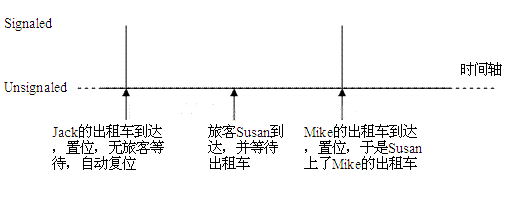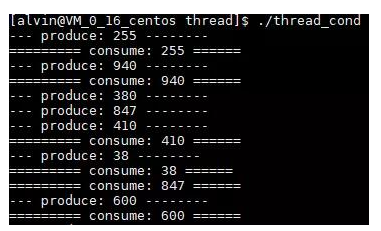本文主要分为三个部分:
一、线程简介及使用
正确的使用线程是一个优秀程序员必备的素质。线程类似于进程,单处理器系统中内核通过时间片轮转模拟线程的并发运行。那么,对于大多数合作任务,为什么多线程比多进程优越呢?
这是因为,线程共享相同的内存空间,不同线程之间可以共享内存中的全局变量。使用fork()写过子进程的同学都会意识到多线程的重要性。为什么呢?虽然fork()允许创建多个进程,但它会带来进程之间的通信问题:各个进程都有各自独立的内存空间,需要使用某种IPC(进程间通信)进行通信,但它们都遇到两个重要障碍:
- 强加了某种形式的额外内核开销,从而降低性能。
- 对于大多数情形,IPC 不是对于代码的“自然”扩展。通常极大地增加了程序的复杂性。
POSIX多线程不必使用诸如管道、套接字等长距离通信,这些通信方式开销大、复杂,由于所有线程都驻留在同一内存空间,因此只需要考虑同步问题即可。
线程是快捷的
与标准fork()相比,线程开销较少。无需单独复制进程的内存空间或文件描述符等等,大大节省CPU时间,创建速度比进程创建快到10-100倍,那么可以大量使用线程而无需担心CPU或内存不足。
同时,线程能够充分利用多处理器的CPU,特定类型线程(CPU密集型)的性能随处理器数目线性提高。如果编写的是CPU密集型程序,则绝对要在代码中使用多线程,无需使用繁琐的IPC及其他复杂通信机制。
线程是可移植的
fork()的底层系统调用是__clone(),新的子进程根据该系统调用的参数有选择的共享父进程的执行环境(内存空间,文件描述符等),但__clone()也有不好的一面,__clone()是特定于Linux平台的,不使用于实现可移植程序。而Linux的POSIX线程是可移植的,代码运行于Solaris、FreeBSD、Linux 和其它平台。
代码:
#include
#include
#include
void *thread_function(void *arg) {
int i;
for ( i=0; i<20; i++) {
printf("Thread says hi!n");
sleep(1);
}
return NULL;
}
int main(void) {
pthread_t mythread;
if ( pthread_create( &mythread, NULL, thread_function, NULL) ) {
printf("error creating thread.");
abort();
}
if ( pthread_join ( mythread, NULL ) ) {
printf("error joining thread.");
abort();
}
exit(0);
}
该程序非常简单,但是也有我们需要学习的地方:
1)线程id的类型为pthread_t,可以认为它是一种句柄,后续的使用都是利用它完成的
2)线程创建函数需要依次指定线程属性、回调函数以及线程传参(简单变量或结构体),返回值考虑
3)线程创建后两个线程如何运行,子线程结束后如何处理
对于第三个问题:
子线程创建后,POSIX线程标准将它们视为相同等级的线程,子线程开始执行的同时,主线程继续向下执行(其实这里已经没有像进程那样的父子概念了,这里只是为了更好的区分),二者并没有一定的先后顺序,CPU时间片的分配取决于内核和线程库。
子线程结束时的处理,当子线程的默认joinable属性时,由主线程对其进行清理;当子线程为detached属性时,由系统进程对其清理。如果未对线程进行正确清理,最终会导致 pthread_create() 调用失败。
代码2:
#include
#include
#include
int myglobal;
void *thread_function(void *arg) {
int i,j;
for ( i=0; i<20; i++) {
j=myglobal;
j=j+1;
printf(".");
fflush(stdout);
sleep(1);
myglobal=j;
}
return NULL;
}
int main(void) {
pthread_t mythread;
int i;
if ( pthread_create( &mythread, NULL, thread_function, NULL) ) {
printf("error creating thread.");
abort();
}
for ( i=0; i<20; i++) {
myglobal=myglobal+1;
printf("o");
fflush(stdout);
sleep(1);
}
if ( pthread_join ( mythread, NULL ) ) {
printf("error joining thread.");
abort();
}
printf("nmyglobal equals %dn",myglobal);
exit(0);
}
输出:

非常意外吧,主线程和子线程各自对myglobal进行20次加1操作,程序结束时myglobal应当为40,然而myglobal的输出为21,这里面肯定有问题。究竟是为什么呢?
核心原因就是:对全局变量的修改并不是原子操作,假设子线程读取全局变量到寄存器,寄存器内部完成加1,之后即将重新赋值给全局变量前的时刻。主线程开始读取全局变量完成操作,那么此时就覆盖了子线程的这一环节操作,该操作也就成了无效操作。


解决这一问题就需要互斥操作了,见第二部分。
二、互斥锁及条件变量的使用
通过互斥锁 (mutex)完成对临界资源的锁操作,能够保证各个线程对其的唯一访问。
互斥对象的工作原理:
如果线程 a 试图锁定一个互斥对象,而此时线程 b 已锁定了同一个互斥对象时,线程 a 就将进入睡眠状态。一旦线程 b 释放了互斥对象(通过 pthread_mutex_unlock() 调用),线程 a 就能够锁定这个互斥对象(换句话说,线程 a 就将从 pthread_mutex_lock() 函数调用中返回,同时互斥对象被锁定)。同样地,其他对已锁定的互斥对象上调用 pthread_mutex_lock() 的所有线程都将进入睡眠状态,这些睡眠的线程将“排队”访问这个互斥对象。

看到了吗?其他试图访问已被锁定互斥对象的线程都会排队睡眠的:)
代码修改:
#include
#include
#include
int myglobal;
pthread_mutex_t mymutex=PTHREAD_MUTEX_INITIALIZER;
void *thread_function(void *arg) {
int i,j;
for ( i=0; i<20; i++) {
pthread_mutex_lock(&mymutex);
j=myglobal;
j=j+1;
printf(".");
fflush(stdout);
sleep(1);
myglobal=j;
pthread_mutex_unlock(&mymutex);
}
return NULL;
}
int main(void) {
pthread_t mythread;
int i;
if ( pthread_create( &mythread, NULL, thread_function, NULL) ) {
printf("error creating thread.");
abort();
}
for ( i=0; i<20; i++) {
pthread_mutex_lock(&mymutex);
myglobal=myglobal+1;
pthread_mutex_unlock(&mymutex);
printf("o");
fflush(stdout);
sleep(1);
}
if ( pthread_join ( mythread, NULL ) ) {
printf("error joining thread.");
abort();
}
printf("nmyglobal equals %dn",myglobal);
exit(0);
}
此时pthread_mutex_lock() 和 pthread_mutex_unlock() 函数调用,如同“在施工中”标志一样,将正在修改和读取的某一特定共享数据包围起来。其他线程访问时继续睡眠,直到该线程完成对其的操作。
等待条件之POSIX条件变量
互斥对象是线程程序必需的工具,但它们并非万能的。例如,如果线程正在等待共享数据内某个条件出现,那会发生什么呢?
1)使用忙查询的方法非常浪费时间和资源,效率非常低。代码可以反复对互斥对象锁定和解锁,以检查值的任何变化。同时,还要快速将互斥对象解锁,以便其它线程能够进行任何必需的更改。这是一种非常可怕的方法,因为线程需要在合理的时间范围内频繁地循环检测变化。
2)解决这个问题的最好方法是使用pthread_cond_wait() 调用来等待特殊条件发生。当线程在等待满足某些条件时使线程进入睡眠状态。一旦条件满足,还需要一种方法以唤醒因等待满足特定条件而睡眠的线程。如果能够做到这一点,线程代码将是非常高效的,并且不会占用宝贵的互斥对象锁。这正是 POSIX 条件变量能做的事!
了解 pthread_cond_wait() 的作用非常重要 – 它是 POSIX 线程信号发送系统的核心,也是最难以理解的部分。
条件变量的概念
通常在程序里,我们使用条件变量来表示等待”某一条件”的发生。虽然名叫”条件变量”,但是它本身并不保存条件状态,本质上条件变量仅仅是一种通讯机制:当有一个线程在等待(pthread_cond_wait)某一条件变量的时候,会将当前的线程挂起,直到另外的线程发送信号(pthread_cond_signal)通知其解除阻塞状态。
由于要用额外的共享变量保存条件状态(这个变量可以是任何类型比如bool),由于这个变量会同时被不同的线程访问,因此需要一个额外的mutex保护它。
《Linux系统编程手册》也有这个问题的介绍:
A condition variable is always used in conjunction with a mutex. The mutex provides mutual exclusion for accessing the shared variable, while the condition variable is used to signal changes in the variable’s state.
条件变量总是结合mutex使用,条件变量就共享变量的状态改变发出通知,mutex就是用来保护这个共享变量的。
cpp官网描述
pthread_cond_wait实现步骤
首先,我们使用条件变量的接口实现一个简单的生产者-消费者模型,avail就是保存条件状态的共享变量,它对生产者线程、消费者线程均可见。不考虑错误处理,先看生产者实现:
avail++;
pthread_mutex_unlock(&mutex);
pthread_cond_signal(&cond); /* Wake sleeping consumer */
因为avail对两个线程都可见,因此对其修改均应该在mutex的保护之下,再来看消费者线程实现:
{
pthread_mutex_lock(&mutex);
while (avail == 0)
pthread_cond_wait(&cond, &mutex);
while (avail > 0)
{
/* Do something */
avail--;
}
pthread_mutex_unlock(&mutex);
}
当”avail==0”时,消费者线程会阻塞在pthread_cond_wait()函数上。如果pthread_cond_wait()仅需要一个pthread_cond_t参数的话,此时mutex已经被锁,要是不先将mutex变量解锁,那么其他线程(如生产者线程)永远无法访问avail变量,也就无法继续生产,消费者线程会一直阻塞下去。
因此pthread_cond_wait()对mutex解锁,然后进入睡眠状态,等待cond以接收POSIX 线程“信号”。一旦接收到“信号”(加引号是因为我们并不是在讨论传统的 UNIX 信号,而是来自pthread_cond_signal() 或 pthread_cond_broadcast() 调用的信号),它就会苏醒。但 pthread_cond_wait() 没有立即返回 – 它还要做一件事:重新锁定 mutex。
理解后提问:调用 pthread_cond_wait() 之 前,互斥对象必须处于什么状态?pthread_cond_wait() 调用返回之后,互斥对象处于什么状态?这两个问题的答案都是“锁定”。
综上,pthread_cond_wait()函数大致会分为3个部分:
1.解锁互斥量mutex 2.阻塞调用线程,直到当前的条件变量收到通知 3.重新锁定互斥量mutex
其中1和2是原子操作,也就是说在pthread_cond_wait()调用线程陷入阻塞之前其他的线程无法获取当前的mutex,也就不能就该条件变量发出通知。
虚假唤醒
前面判断条件状态的时候avail > 0放在了while循环中,而不是if中,这是因为pthread_cond_wait()阻塞在条件变量上的时候,即使其他的线程没有就该条件变量发出通知(pthread_cond_signal()/pthread_cond_broadcast()),条件变量也有可能会自己醒来(pthread_cond_wait()函数返回),因此需要重新检查一下共享变量上的条件成不成立,确保条件变量是真的收到了通知,否则继续阻塞等待。关于虚假唤醒的相关介绍,可以戳这里查看维基百科下面的几个引用:https://en.wikipedia.org/wiki/Spurious_wakeup。
三、工作队列的实现
这里摘抄IBM第三部分应用实现代码:
在这个方案中,我们创建了许多工作程序线程。每个线程都会检查 wq(“工作队列”),查看是否有需要完成的工作。如果有需要完成的工作,那么线程将从队列中除去一个节点,执行这些特定工作,然后等待新的工作到达。
与此同时,主线程负责创建这些工作程序线程、将工作添加到队列,然后在它退出时收集所有工作程序线程。您将会遇到许多 C 代码,好好准备吧!
队列
需要队列是出于两个原因。首先,需要队列来保存工作作业。还需要可用于跟踪已终止线程的数据结构。还记得前几篇文章(请参阅本文结尾处的 参考资料)中,我曾提到过需要使用带有特定进程标识的 pthread_join 吗?使用“清除队列”(称作 “cq”)可以解决无法等待 任何已终止线程的问题(稍后将详细讨论这个问题)。以下是标准队列代码。将此代码保存到文件 queue.h 和 queue.c:
queue.h
** Copyright 2000 Daniel Robbins, Gentoo Technologies, Inc.
** Author: Daniel Robbins
** Date: 16 Jun 2000
*/
typedef struct node {
struct node *next;
} node;
typedef struct queue {
node *head, *tail;
} queue;
void queue_init(queue *myroot);
void queue_put(queue *myroot, node *mynode);
node *queue_get(queue *myroot);
queue.c
** Copyright 2000 Daniel Robbins, Gentoo Technologies, Inc.
** Author: Daniel Robbins
** Date: 16 Jun 2000
**
** This set of queue functions was originally thread-aware. I
** redesigned the code to make this set of queue routines
** thread-ignorant (just a generic, boring yet very fast set of queue
** routines). Why the change? Because it makes more sense to have
** the thread support as an optional add-on. Consider a situation
** where you want to add 5 nodes to the queue. With the
** thread-enabled version, each call to queue_put() would
** automatically lock and unlock the queue mutex 5 times -- that's a
** lot of unnecessary overhead. However, by moving the thread stuff
** out of the queue routines, the caller can lock the mutex once at
** the beginning, then insert 5 items, and then unlock at the end.
** Moving the lock/unlock code out of the queue functions allows for
** optimizations that aren't possible otherwise. It also makes this
** code useful for non-threaded applications.
**
** We can easily thread-enable this data structure by using the
** data_control type defined in control.c and control.h. */
#include
#include "queue.h"
void queue_init(queue *myroot) {
myroot->head=NULL;
myroot->tail=NULL;
}
void queue_put(queue *myroot,node *mynode) {
mynode->next=NULL;
if (myroot->tail!=NULL)
myroot->tail->next=mynode;
myroot->tail=mynode;
if (myroot->head==NULL)
myroot->head=mynode;
}
node *queue_get(queue *myroot) {
//get from root
node *mynode;
mynode=myroot->head;
if (myroot->head!=NULL)
myroot->head=myroot->head->next;
return mynode;
}
data_control 代码
我编写的并不是线程安全的队列例程,事实上我创建了一个“数据包装”或“控制”结构,它可以是任何线程支持的数据结构。看一下 control.h:
typedef struct data_control {
pthread_mutex_t mutex;
pthread_cond_t cond;
int active;
} data_control;
现在您看到了 data_control 结构定义,以下是它的视觉表示:
所使用的 data_control 结构

图像中的锁代表互斥对象,它允许对数据结构进行互斥访问。黄色的星代表条件变量,它可以睡眠,直到所讨论的数据结构改变为止。on/off 开关表示整数 “active”,它告诉线程此数据是否是活动的。在代码中,我使用整数 active 作为标志,告诉工作队列何时应该关闭。以下是 control.c:
control.c
** Copyright 2000 Daniel Robbins, Gentoo Technologies, Inc.
** Author: Daniel Robbins
** Date: 16 Jun 2000
**
** These routines provide an easy way to make any type of
** data-structure thread-aware. Simply associate a data_control
** structure with the data structure (by creating a new struct, for
** example). Then, simply lock and unlock the mutex, or
** wait/signal/broadcast on the condition variable in the data_control
** structure as needed.
**
** data_control structs contain an int called "active". This int is
** intended to be used for a specific kind of multithreaded design,
** where each thread checks the state of "active" every time it locks
** the mutex. If active is 0, the thread knows that instead of doing
** its normal routine, it should stop itself. If active is 1, it
** should continue as normal. So, by setting active to 0, a
** controlling thread can easily inform a thread work crew to shut
** down instead of processing new jobs. Use the control_activate()
** and control_deactivate() functions, which will also broadcast on
** the data_control struct's condition variable, so that all threads
** stuck in pthread_cond_wait() will wake up, have an opportunity to
** notice the change, and then terminate.
*/
#include "control.h"
int control_init(data_control *mycontrol) {
int mystatus;
if (pthread_mutex_init(&(mycontrol->mutex),NULL))
return 1;
if (pthread_cond_init(&(mycontrol->cond),NULL))
return 1;
mycontrol->active=0;
return 0;
}
int control_destroy(data_control *mycontrol) {
int mystatus;
if (pthread_cond_destroy(&(mycontrol->cond)))
return 1;
if (pthread_cond_destroy(&(mycontrol->cond)))
return 1;
mycontrol->active=0;
return 0;
}
int control_activate(data_control *mycontrol) {
int mystatus;
if (pthread_mutex_lock(&(mycontrol->mutex)))
return 0;
mycontrol->active=1;
pthread_mutex_unlock(&(mycontrol->mutex));
pthread_cond_broadcast(&(mycontrol->cond));
return 1;
}
int control_deactivate(data_control *mycontrol) {
int mystatus;
if (pthread_mutex_lock(&(mycontrol->mutex)))
return 0;
mycontrol->active=0;
pthread_mutex_unlock(&(mycontrol->mutex));
pthread_cond_broadcast(&(mycontrol->cond));
return 1;
}
调试时间
在开始调试之前,还需要一个文件。以下是 dbug.h:
{ printf("Aborting at line %d in source file %sn",__LINE__,__FILE__); abort(); }
此代码用于处理工作组代码中的不可纠正错误。
工作组代码说到工作组代码,以下就是:workcrew.c
#include
#include "control.h"
#include "queue.h"
#include "dbug.h"
/* the work_queue holds tasks for the various threads to complete. */
struct work_queue {
data_control control;
queue work;
} wq;
/* I added a job number to the work node. Normally, the work node
would contain additional data that needed to be processed. */
typedef struct work_node {
struct node *next;
int jobnum;
} wnode;
/* the cleanup queue holds stopped threads. Before a thread
terminates, it adds itself to this list. Since the main thread is
waiting for changes in this list, it will then wake up and clean up
the newly terminated thread. */
struct cleanup_queue {
data_control control;
queue cleanup;
} cq;
/* I added a thread number (for debugging/instructional purposes) and
a thread id to the cleanup node. The cleanup node gets passed to
the new thread on startup, and just before the thread stops, it
attaches the cleanup node to the cleanup queue. The main thread
monitors the cleanup queue and is the one that performs the
necessary cleanup. */
typedef struct cleanup_node {
struct node *next;
int threadnum;
pthread_t tid;
} cnode;
void *threadfunc(void *myarg) {
wnode *mywork;
cnode *mynode;
mynode=(cnode *) myarg;
pthread_mutex_lock(&wq.control.mutex);
while (wq.control.active) {
while (wq.work.head==NULL && wq.control.active) {
pthread_cond_wait(&wq.control.cond, &wq.control.mutex);
}
if (!wq.control.active)
break;
//we got something!
mywork=(wnode *) queue_get(&wq.work);
pthread_mutex_unlock(&wq.control.mutex);
//perform processing...
printf("Thread number %d processing job %dn",mynode->threadnum,mywork->jobnum);
free(mywork);
pthread_mutex_lock(&wq.control.mutex);
}
pthread_mutex_unlock(&wq.control.mutex);
pthread_mutex_lock(&cq.control.mutex);
queue_put(&cq.cleanup,(node *) mynode);
pthread_mutex_unlock(&cq.control.mutex);
pthread_cond_signal(&cq.control.cond);
printf("thread %d shutting down...n",mynode->threadnum);
return NULL;
}
#define NUM_WORKERS 4
int numthreads;
void join_threads(void) {
cnode *curnode;
printf("joining threads...n");
while (numthreads) {
pthread_mutex_lock(&cq.control.mutex);
/* below, we sleep until there really is a new cleanup node. This
takes care of any false wakeups... even if we break out of
pthread_cond_wait(), we don't make any assumptions that the
condition we were waiting for is true. */
while (cq.cleanup.head==NULL) {
pthread_cond_wait(&cq.control.cond,&cq.control.mutex);
}
/* at this point, we hold the mutex and there is an item in the
list that we need to process. First, we remove the node from
the queue. Then, we call pthread_join() on the tid stored in
the node. When pthread_join() returns, we have cleaned up
after a thread. Only then do we free() the node, decrement the
number of additional threads we need to wait for and repeat the
entire process, if necessary */
curnode = (cnode *) queue_get(&cq.cleanup);
pthread_mutex_unlock(&cq.control.mutex);
pthread_join(curnode->tid,NULL);
printf("joined with thread %dn",curnode->threadnum);
free(curnode);
numthreads--;
}
}
int create_threads(void) {
int x;
cnode *curnode;
for (x=0; x curnode=malloc(sizeof(cnode));
if (!curnode)
return 1;
curnode->threadnum=x;
if (pthread_create(&curnode->tid, NULL, threadfunc, (void *) curnode))
return 1;
printf("created thread %dn",x);
numthreads++;
}
return 0;
}
void initialize_structs(void) {
numthreads=0;
if (control_init(&wq.control))
dabort();
queue_init(&wq.work);
if (control_init(&cq.control)) {
control_destroy(&wq.control);
dabort();
}
queue_init(&wq.work);
control_activate(&wq.control);
}
void cleanup_structs(void) {
control_destroy(&cq.control);
control_destroy(&wq.control);
}
int main(void) {
int x;
wnode *mywork;
initialize_structs();
/* CREATION */
if (create_threads()) {
printf("Error starting threads... cleaning up.n");
join_threads();
dabort();
}
pthread_mutex_lock(&wq.control.mutex);
for (x=0; x<16000; x++) {
mywork=malloc(sizeof(wnode));
if (!mywork) {
printf("ouch! can't malloc!n");
break;
}
mywork->jobnum=x;
queue_put(&wq.work,(node *) mywork);
}
pthread_mutex_unlock(&wq.control.mutex);
pthread_cond_broadcast(&wq.control.cond);
printf("sleeping...n");
sleep(2);
printf("deactivating work queue...n");
control_deactivate(&wq.control);
/* CLEANUP */
join_threads();
cleanup_structs();
};>
代码初排
现在来快速初排代码。定义的第一个结构称作 “wq”,它包含了 data_control 和队列头。data_control 结构用于仲裁对整个队列的访问,包括队列中的节点。下一步工作是定义实际的工作节点。要使代码符合本文中的示例,此处所包含的都是作业号。
接着,创建清除队列。注释说明了它的工作方式。好,现在让我们跳过 threadfunc()、join_threads()、create_threads() 和 initialize_structs() 调用,直接跳到 main()。所做的第一件事就是初始化结构 – 这包括初始化 data_controls 和队列,以及激活工作队列。
有关清除的注意事项
现在初始化线程。如果看一下 create_threads() 调用,似乎一切正常 – 除了一件事。请注意,我们正在分配清除节点,以及初始化它的线程号和 TID 组件。我们还将清除节点作为初始自变量传递给每一个新的工作程序线程。为什么这样做?
因为当某个工作程序线程退出时,它会将其清除节点连接到清除队列,然后终止。那时,主线程会在清除队列中检测到这个节点(利用条件变量),并将这个节点移出队列。因为 TID(线程标识)存储在清除节点中,所以主线程可以确切知道哪个线程已终止了。然后,主线程将调用 pthread_join(tid),并联接适当的工作程序线程。如果没有做记录,那么主线程就需要按任意顺序联接工作程序线程,可能是按它们的创建顺序。由于线程不一定按此顺序终止,那么主线程可能会在已经联接了十个线程时,等待联接另一个线程。您能理解这种设计决策是如何使关闭代码加速的吗(尤其在使用几百个工作程序线程的情况下)?
创建工作
我们已启动了工作程序线程(它们已经完成了执行 threadfunc(),稍后将讨论此函数),现在主线程开始将工作节点插入工作队列。首先,它锁定 wq 的控制互斥对象,然后分配 16000 个工作包,将它们逐个插入队列。完成之后,将调用 pthread_cond_broadcast(),于是所有正在睡眠的线程会被唤醒,并开始执行工作。此时,主线程将睡眠两秒钟,然后释放工作队列,并通知工作程序线程终止活动。接着,主线程会调用 join_threads() 函数来清除所有工作程序线程。
threadfunc()
现在来讨论 threadfunc(),这是所有工作程序线程都要执行的代码。当工作程序线程启动时,它会立即锁定工作队列互斥对象,获取一个工作节点(如果有的话),然后对它进行处理。如果没有工作,则调用 pthread_cond_wait()。您会注意到这个调用在一个非常紧凑的 while() 循环中,这是非常重要的。当从 pthread_cond_wait() 调用中苏醒时,决不能认为条件肯定发生了 – 它 可能发生了,也可能没有发生。如果发生了这种情况,即错误地唤醒了线程,而列表是空的,那么 while 循环将再次调用 pthread_cond_wait()。
如果有一个工作节点,那么我们只打印它的作业号,释放它并退出。然而,实际代码会执行一些更实质性的操作。在 while() 循环结尾,我们锁定了互斥对象,以便检查 active 变量,以及在循环顶部检查新的工作节点。如果执行完此代码,就会发现如果 wq.control.active 是 0,while 循环就会终止,并会执行 threadfunc() 结尾处的清除代码。
工作程序线程的清除代码部件非常有趣。首先,由于 pthread_cond_wait() 返回了锁定的互斥对象,它会对 work_queue 解锁。然后,它锁定清除队列,添加清除代码(包含了 TID,主线程将使用此 TID 来调用 pthread_join()),然后再对清除队列解锁。此后,它发信号给所有 cq 等待者 (pthread_cond_signal(&cq.control.cond)),于是主线程就知道有一个待处理的新节点。我们不使用 pthread_cond_broadcast(),因为没有这个必要 – 只有一个线程(主线程)在等待清除队列中的新节点。当它调用 join_threads() 时,工作程序线程将打印关闭消息,然后终止,等待主线程发出的 pthread_join() 调用。
join_threads()
如果要查看关于如何使用条件变量的简单示例,请参考 join_threads() 函数。如果还有工作程序线程,join_threads() 会一直执行,等待清除队列中新的清除节点。如果有新节点,我们会将此节点移出队列、对清除队列解锁(从而使工作程序可以添加清除节点)、联接新的工作程序线程(使用存储在清除节点中的 TID)、释放清除节点、减少“现有”线程的数量,然后继续。

-
cpu
+关注
关注
68文章
10858浏览量
211670 -
通信
+关注
关注
18文章
6029浏览量
135969 -
处理器系统
+关注
关注
0文章
9浏览量
7790 -
线程
+关注
关注
0文章
504浏览量
19677
发布评论请先 登录
相关推荐
线程 ,生产者. 消费者 互斥锁,条件变量
【HarmonyOS HiSpark AI Camera试用连载 】第三次回眸-鸿蒙的线程和互斥锁
【HarmonyOS HiSpark AI Camera 】第三次回眸-鸿蒙的线程和互斥锁
i.MX6ULL开发板线程同步POSIX无名信号量
Linux C多线程编程之互斥锁与条件变量实例详解
深入了解互斥锁、条件变量、读写锁以及自旋锁
互斥锁、条件变量、读写锁、自旋锁及信号量介绍





 互斥锁及条件变量的使用
互斥锁及条件变量的使用












评论